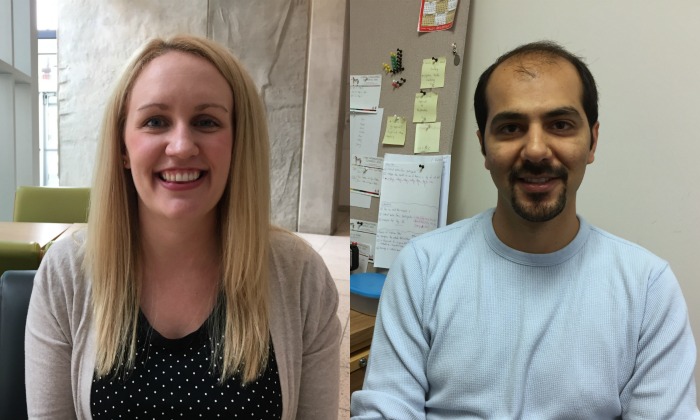
2018 Vanier scholars Haley Schafer and Milad Nazarahari.
(Edmonton) Two University of Alberta engineering graduate students have earned prestigious scholarships allowing them to focus on projects impacting health care and the environment.
Haley Schafer and Milad Nazarahari both received Vanier Graduate Scholarships during a visit to the U of A by federal Minister of Science and Sport Kirsty Duncan.
Minister Duncan announced 167 new Vanier recipients and 70 new Banting Postdoctoral Fellowships being distributed nationally. The combined value of the awards is $34.5 million.
"When I was completing my master's, I constantly worried about applying for scholarships," said Schafer. "The Vanier scholarship is going to allow me to focus entirely on my research."
Schafer earned her undergraduate degree in civil engineering in 2014 and her master's degree in geoenvironmental engineering last year. She's now working toward her PhD, researching the long-term behaviour of mine tailings-including those produced at Alberta's oil sands mines.
"Mines create liquid waste called tailings, which are contained in tailings dams," explained Schafer. "After a mine closes, these structures are left onsite forever. This is a problem because we don't know how they behave long term."
Schafer discovered her passion for the geotechnical discipline during her first year of engineering studies at the U of A.
"One of the things about geotechnical engineering is that it's very unpredictable," she said. "What you have under the ground right here might be completely different from over there. It's an interesting engineering problem, and I really like that."
When she entered into the co-op portion of her undergraduate degree, she immediately applied for jobs pertaining to geotechnical engineering and never looked back.
For Nazarahari, the funding will help him develop a high-tech tool to assist stroke patients.
The second-year mechanical engineering PhD student is developing wearable sensors that track movements of patients, helping them relearn to walk.
"The problem is that in-person sessions with a physical therapist isn't always available-they get maybe only a couple of hours a week," said Nazarahari. "Stroke patients do their walking exercises by themselves most of the time, which can lead to relearning of pathological walking problems."
The aim of Nazarahari's work is to develop variable sensor technology that can be worn by stroke victims in order to collect data on their progress.
"Using five or six small sensors worn on the body, we can identify and extract features of their walking and provide the feedback to their therapist," he said. "That feedback can help them to modify their walking pattern and improve their relearning process."
Nazarahari completed his mechanical engineering baccalaureate and master's degrees in Iran, and came to do his doctoral studies at the University of Alberta under the supervision of Hossein Rouhani, mechanical engineering professor.
"I find that the synergy between mechanical engineering and biomedical engineering can be really helpful because you can develop a product or technology that can be helpful directly for people," said Nazarahari.
During his undergraduate studies, Nazarahari volunteered at a hospital working with children who had blood cancer. It made a huge impact on him and his decision to pursue the biomedical field.
"We can improve their life, and help treat the bad things that they are dealing with every day-that was one of the main reasons that I chose to pursue developing biomedical technologies."